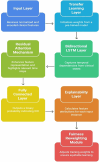Explainable Transfer Learning with Residual Attention BiLSTM for Prognosis of Ischemic Heart Disease
- PMID: 41216267
- PMCID: PMC12596549
- DOI: 10.12688/f1000research.166307.2
Explainable Transfer Learning with Residual Attention BiLSTM for Prognosis of Ischemic Heart Disease
Abstract
Background: Early and accurate prediction of Ischemic Heart Disease (IHD) is critical to reducing cardiovascular mortality through timely intervention. While deep learning (DL) models have shown promise in disease prediction, many lack interpretability, generalizability, and fairness-particularly when deployed across demographically diverse populations. These shortcomings limit clinical adoption and risk reinforcing healthcare disparities.
Methods: This study proposes a novel model: X-TLRABiLSTM (Explainable Transfer Learning-based Residual Attention Bidirectional LSTM). The architecture integrates transfer learning from pre-trained cardiovascular models into a BiLSTM framework with residual attention layers to improve temporal feature extraction and convergence. To ensure transparency, the model incorporates SHAP (SHapley Additive exPlanations) to quantify the contribution of each clinical feature to the final prediction. Additionally, a demographic reweighting strategy is applied to the training process to reduce bias across subgroups defined by age, gender, and ethnicity. The model was evaluated on the UCI Heart Disease dataset using 10-fold cross-validation.
Results: The X-TLRABiLSTM model achieved a classification accuracy of 98.2%, with an F1-score of 98.1% and an AUC of 99.1%, outperforming standard ML classifiers and state-of-the-art DL baselines. SHAP-based interpretability analysis highlighted clinically relevant predictors such as chest pain type, ST depression, and thalassemia. A fairness-aware reweighting strategy was applied during training, and fairness evaluation revealed minimal performance disparity across demographic subgroups, with F1-score gaps ≤ 0.6% and error rate gaps ≤ 0.4%. Confusion matrix analysis demonstrated low false-positive and false-negative rates, reinforcing the model's reliability for clinical deployment.
Conclusions: X-TLRABiLSTM offers a highly accurate, interpretable, and demographically fair framework for IHD prognosis. By combining transfer learning, residual attention, explainable AI, and fairness-aware optimization, this model advances trustworthy AI in healthcare. Its successful performance on benchmark clinical data supports its potential for real-world integration in ethical, AI-assisted cardiovascular diagnostics.
Keywords: Bidirectional LSTM (BiLSTM); Clinical Decision Support Systems; Deep Learning; Demographic Bias Mitigation; Explainable AI (XAI); Fairness in AI; Ischemic Heart Disease (IHD); Residual Attention Mechanism; SHAP; Transfer Learning.
Copyright: © 2025 D C et al.
Conflict of interest statement
No competing interests were disclosed.
Figures






References
-
- World Health Organization: Cardiovascular Diseases (CVDs). 2023. Reference Source
-
- Cenitta D, et al. : Ischemic Heart Disease Prognosis: A Hybrid Residual Attention-Enhanced LSTM Model. IEEE Access. 2024.
-
- Bhavekar GS, Goswami AD: A hybrid model for heart disease prediction using recurrent neural network and long short term memory. Int. J. Inf. Technol. 2022;14(4):1781–1789.
-
- Liu Y, et al. : Automatic detection of ECG abnormalities by using an ensemble of deep residual networks with attention. Machine Learning and Medical Engineering for Cardiovascular Health and Intravascular Imaging and Computer Assisted Stenting: First International Workshop, MLMECH 2019, and 8th Joint International Workshop, CVII-STENT 2019, Held in Conjunction with MICCAI 2019, Shenzhen, China, October 13, 2019, Proceedings 1. Springer International Publishing;2019.
MeSH terms
LinkOut - more resources
Full Text Sources
Medical

